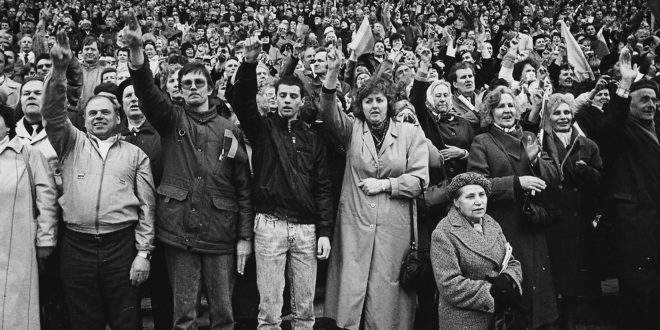Victor Nakas.
Imagine a world in which your local university offers a course in modern Lithuanian history. Of course you’ve enrolled and now it’s time for your final exam. Your first essay question reads “What were the five most important milestones in 20th century Lithuanian history? Why?”
How would you respond?
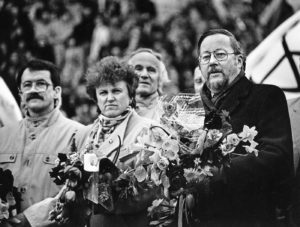
My guess is that the two declarations of national independence – February 16, 1918, and March 11, 1990 – would be on everyone’s list. After that, opinions would diverge. For my part, I would be strongly inclined to select January 13, 1991, as the third most important event. As we approach the 30th anniversary of that milestone, perhaps the best way to assess the event is to remind ourselves of its particulars, to reflect on how it represented both tragedy and triumph, and to consider its impact in Lithuania and beyond.
Before we focus on Vilnius, let’s recall how the Lithuanian saga fit into the remarkable changes that transpired in Europe during the waning years of the Cold War. After Mikhail Gorbachev became general secretary of the Communist Party of the USSR (March 1985), he embarked on an ambitious program to resuscitate the moribund Communist system. Gradually, he loosened the Communist Party’s stranglehold on Soviet society, committed to nuclear arms and troop reductions in Europe, and allowed Central Europe to spin out of the Soviet orbit, culminating in his acceptance of a unified Germany in NATO (July 1990).
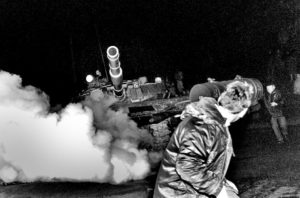
Overt orthodox Communist opposition to Gorbachev’s moves toward a less repressive and militaristic regime emerged in 1988 and intensified in 1990 and 1991, as the Soviet ruler played hardliners and reformers in his inner circle off against each other. Though Gorbachev was willing to let the Warsaw Pact disintegrate, he was relentlessly hostile toward moves by nations within the inner Soviet empire to assert their national autonomy. When Lithuania became the first so-called “Soviet republic” to declare independence on March 11, Gorbachev imposed an economic blockade that he expected would cause a popular revolt by Lithuanian citizens against their government. He believed that national consciousness was a “false idea” and that the Lithuanians would succumb to economic and military pressure. After 75 days of economic hardship for Lithuanians and embarrassment to Gorbachev over the failure of his bullying to bring the Lithuanian government to its knees, the two sides struck a face-saving agreement that didn’t end the impasse over independence.
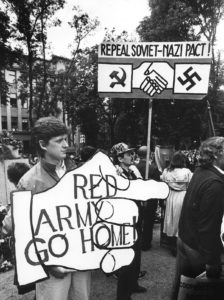 The outcome at the time could have been much worse for Lithuania. At a March 22 Politburo meeting, Gorbachev had rejected a proposal by one of his generals to impose presidential rule in Lithuania. That same day, Soviet Defense Minister Dmitri Yazov wrote in his diary: “To be ready to take the TV center.” On April 9, Yazov added the following entries: “General strike! A telegram will be sent for them to abolish their resolutions, restore the constitution,” “About 200 armed men, in the Hall and the Supreme Council,” and “The publishing house belongs to the CPSU [Soviet Communist Party] – capture it!” These jottings foreshadowed the attack plan that was to be executed in Lithuania nine months later.
The outcome at the time could have been much worse for Lithuania. At a March 22 Politburo meeting, Gorbachev had rejected a proposal by one of his generals to impose presidential rule in Lithuania. That same day, Soviet Defense Minister Dmitri Yazov wrote in his diary: “To be ready to take the TV center.” On April 9, Yazov added the following entries: “General strike! A telegram will be sent for them to abolish their resolutions, restore the constitution,” “About 200 armed men, in the Hall and the Supreme Council,” and “The publishing house belongs to the CPSU [Soviet Communist Party] – capture it!” These jottings foreshadowed the attack plan that was to be executed in Lithuania nine months later.
Gorbachev’s Lithuania problem was compounded by other events challenging the supremacy of the Soviet state. In June the Russian republic declared its sovereignty. In October Russia and Ukraine announced that their laws took precedence over Soviet law. According to President George H.W. Bush’s former deputy national security adviser, “Realization that the Soviet Union was slipping away from him, just as Eastern Europe had, at this point [November 1990] prompted a radical shift of political position by Gorbachev, who now made common cause with conservatives.” Confirmation of that came a few days before Christmas. Issuing a public warning that “dictatorship is coming,” Foreign Minister Eduard Shevardnadze resigned.
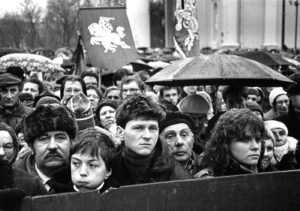 When the new year dawned, Lithuania was still the only republic to have declared an absolute break with Moscow and thus remained in the cross-hairs of orthodox Communists. The stage to take decisive military action was set with a presidential decree by Gorbachev on December 1 calling for the enforcement of conscription throughout the USSR. On January 7, under orders from Defense Minister Yazov, a Soviet paratroop division from Pskov arrived in Lithuania to search for draft evaders and deserters. According to a Lithuanian-American historian who was in Lithuania at the time, this was a ruse: “There was no campaign to find delinquent recruits, and local officials received no orders from Moscow to do so.”
When the new year dawned, Lithuania was still the only republic to have declared an absolute break with Moscow and thus remained in the cross-hairs of orthodox Communists. The stage to take decisive military action was set with a presidential decree by Gorbachev on December 1 calling for the enforcement of conscription throughout the USSR. On January 7, under orders from Defense Minister Yazov, a Soviet paratroop division from Pskov arrived in Lithuania to search for draft evaders and deserters. According to a Lithuanian-American historian who was in Lithuania at the time, this was a ruse: “There was no campaign to find delinquent recruits, and local officials received no orders from Moscow to do so.”
Lithuanian Prime Minister Kazimiera Prunskienė provided a pretext for the next move by proponents of revanchism. Against the wishes of the parliament (Lithuanian Supreme Council), she announced that the price of foodstuffs, heretofore subsidized by the government, would be raised by more than 300%. The following day, supporters of Edinstvo, an extremist Marxist-Leninist organization, stormed the parliament building, demanding the resignation of Prunskienė’s government and the dissolution of the Supreme Council. Though they made it into the first floor of the building, security guards drove them out. Thus Yazov’s spring-time rough sketch encountered its first setback.
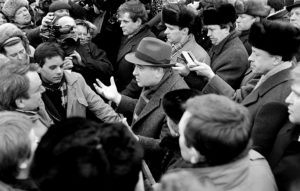
The Supreme Council canceled the price increases and Prunskienė resigned. The Kremlin sought to exploit Lithuania’s political instability. On January 10, Gorbachev issued an ultimatum to the Lithuanian parliament, insisting that it “immediately and completely reestablish the validity of the constitutions of the USSR and Lithuanian SSR, and revoke the anti-constitutional acts which have been adopted.” He threatened to impose presidential rule. On the morning of January 11, Soviet troops seized the Press Center in the Lithuanian capital, sending seven people to the hospital. That afternoon, Juozas Jermalavičius, the ideologist of the rump Communist party that had remained loyal to the Kremlin when the Lithuanian Communist Party declared its independence from Moscow in 1989, announced the existence of an anonymous National Salvation Committee that would “take full responsibility for the fate of the republic.” Late that night, two planeloads carrying members of the elite Alpha Detachment, which reported directly to KGB chief Vladimir Kryuchkov, arrived from Moscow. By this point, the Soviet military had closed the Vilnius airport to the general public and halted train service.
After midnight on January 13, Soviet forces moved against two communication centers: the buildings housing the radio and TV station and the TV tower. They encountered thousands of unarmed civilians who at the urging of Supreme Council chairman Vytautas Landsbergis had camped out at sites that represented the cornerstones of their democracy. The Soviet paratroopers, accompanied by tanks and armored personnel carriers, were tasked with clearing the path for the Alpha unit to seize the two targets. Though Alpha’s specialty was liberating hostages, neutralizing terrorists, and seizing buildings, extrajudicial actions were also part of its portfolio; in 1979, for example, it had assassinated the president of Afghanistan.
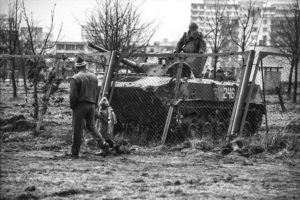
When the assault commenced, 12 civilians were killed on the spot, shot or crushed by tank treads; another two died in the hospital. The Soviets suffered one fatality, an Alpha unit member apparently killed by friendly fire at the radio and television buildings.
In the aftermath of the killings, Soviet tanks blared a recorded message from Jermalavičius announcing that the National Salvation Committee had taken control. Members of the Supreme Council hunkered down, waiting for an assault on the parliament building. And yet, the attack never came; the National Salvation Committee’s influence on the course of events after the killings proved to be less than ephemeral.
What happened? For one thing, the coup plotters apparently miscalculated the level of resistance they would encounter. In the years that have elapsed since January 13, the focus understandably has been on the 14 citizens who paid with their lives to defend their freedom. But it’s also important to remember that more than 500 people were treated for injuries sustained that night. Just as Gorbachev had miscalculated the potential potency of his economic blockade in April, so too did the army, KBG, and local Communist extremists misjudge the efficacy of their resort to brute force. Neither one nor the other cowed Lithuanians into abandoning their elected government. If the coup plotters had anticipated that Gorbachev would use the turmoil to impose presidential rule and suspend the Lithuanian parliament, they were to be disappointed by his indecisiveness. Thereafter, the only way forward for the putschists was to spill a lot more blood. They hesitated.
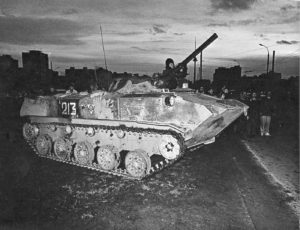
Another thing that the coup plotters hadn’t paid enough attention to was the spotlight that would be shined on their actions. Not for nothing had they decided to attack the TV tower at 2 a.m. when most people could be expected to be in their beds, fast asleep. The plotters probably envisioned that Lithuania’s inhabitants would awaken the next morning to news that overnight a new regime, loyal to Moscow, had been installed and that resistance to the fait accompli would be futile. Instead, a gruesome scene of human shields being shot, beaten, and trampled had been witnessed during the witching hour by a horde of Western correspondents who had arrived in Vilnius in the preceding days, alerted by the gathering storm clouds. While the Soviet military had been menacingly roaming the streets of Vilnius, no one had bothered to hermetically seal the city off from outsiders.
Perhaps the generals had calculated that keeping foreign eyewitnesses out wouldn’t matter much. The West, they thought, was distracted by the coming war to liberate Kuwait from Iraq’s Saddam Hussein. Western media was focusing a great deal of attention on the looming January 15 deadline for Iraq to pull out or face a multinational military attack. President Bush saw Gorbachev’s acquiescence as critically important to the success of his campaign in Kuwait. According to Bush’s deputy national security adviser, when Gorbachev called the President on January 11 and urged unsuccessfully that the attack on Iraq be postponed, to placate the Soviet leader, “Bush soft-pedaled concerns on the Baltics and would continue to do so.” It turned out that the Western media was perfectly capable of covering Kuwait and Lithuania at the same time and unwilling to soft-pedal its reporting about either. The result was a public relations debacle for the coup plotters.
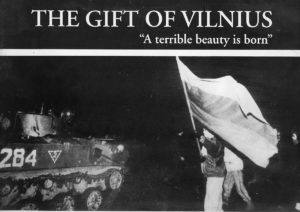 TV and photographic images of the Vilnius victims ricocheted between Moscow and Washington, and beyond. When President Bush returned from Camp David and emerged from his helicopter on the White House lawn on January 13, he asked his waiting Soviet affairs adviser about Vilnius: “How bad is it?” She replied: “Awful. They ran over a 13-year old girl with a tank.” Gorbachev’s chief foreign policy aide recounted what Muscovites were seeing that day: “Television showed the tanks in Vilnius, their turrets pivoting with guns aimed down at the crowds, the girl who had been crushed under the tracks, the old man who’d been shot point-blank.” The “girl” in question was actually 23-year-old Loreta Asanavičiūtė, the sole female fatality. Her gruesome death seemed to imprint itself on the consciousness of the world.
TV and photographic images of the Vilnius victims ricocheted between Moscow and Washington, and beyond. When President Bush returned from Camp David and emerged from his helicopter on the White House lawn on January 13, he asked his waiting Soviet affairs adviser about Vilnius: “How bad is it?” She replied: “Awful. They ran over a 13-year old girl with a tank.” Gorbachev’s chief foreign policy aide recounted what Muscovites were seeing that day: “Television showed the tanks in Vilnius, their turrets pivoting with guns aimed down at the crowds, the girl who had been crushed under the tracks, the old man who’d been shot point-blank.” The “girl” in question was actually 23-year-old Loreta Asanavičiūtė, the sole female fatality. Her gruesome death seemed to imprint itself on the consciousness of the world.
The finger-pointing commenced in Moscow. Gorbachev claimed that he had been asleep during the attack and only awakened after it was over. When a U.S. journalist subsequently asked one of Gorbachev’s former advisers if this scenario was plausible, the latter replied, “Don’t be naive.” Gorbachev made matters worse by asserting that the blame for the Vilnius tragedy lay with Landsbergis and his supporters for staging a “nighttime constitutional coup.” In a classified summary of events in Vilnius prepared for President Bush, the CIA concluded that Gorbachev must have signed off on sending the paratroopers from Pskov and, even if he didn’t order the shooting, was “strategically if not tactically” responsible for the deaths that occurred. Inhabitants of Moscow, from ordinary citizens to influential reformers, were less circumspect. In disgust, Communist Party members turned in their party cards; others denounced Gorbachev as “the leader of a vile regime,” “the biggest liar of our time.” Decades after the January 1991 assault, one historian summed up Gorbachev’s probable culpability this way: “…there was quickly a suspicion that even if he had not ordered [the attack], he had chosen not to prevent it.”
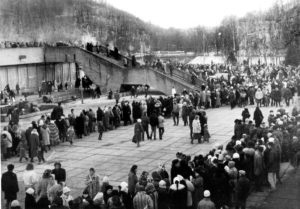 Gorbachev emerged from the Vilnius nightmare with his reputation severely tarnished and his political standing weakened. On January 13 Boris Yelstin flew to Tallinn to sign a statement with the leaders of the three Baltic states recognizing each other’s state sovereignty and pledging to develop relations “on the basis of international law,” i.e. as independent countries.25 This was another nail in the coffin of central Soviet rule.
Gorbachev emerged from the Vilnius nightmare with his reputation severely tarnished and his political standing weakened. On January 13 Boris Yelstin flew to Tallinn to sign a statement with the leaders of the three Baltic states recognizing each other’s state sovereignty and pledging to develop relations “on the basis of international law,” i.e. as independent countries.25 This was another nail in the coffin of central Soviet rule.
Meanwhile, the coup plotters scrambled to cover their tracks. They settled on the cover story that the attack had been the idea of the military garrison commander in Vilnius.26 They concealed the identity of the Alpha unit lieutenant who had been killed, misidentifying him as a paratrooper, because otherwise he and his detachment would have been traced back directly to their boss – KGB chief Kryuchkov in Moscow.27
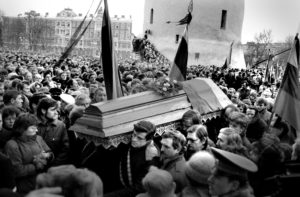
In reality, the unsuccessful January coup was coordinated in the office of Gorbachev’s chief of staff by five people on the night of January 12-13.28 Subsequently all of them were to turn on Gorbachev and play mportant roles in the effort to depose him in August. Having failed to reverse reforms and democratization at the periphery of the empire in winter, they decided that they should try again in the summer, this time at the center. But Vilnius had changed the balance of forces in ways few may have anticipated. With Gorbachev under house arrest in Crimea, resistance to the coup d’etat in Moscow centered on the Russian parliament building (White House) where Boris Yelstin and others were leading the democratic forces. As in Vilnius, thousands of citizens surrounded the building to serve as human shields. Once again, the order came forth from the upper echelons of the military and KGB to prepare for an armed assault. This time, disenchanted by the nefarious use to which they had been put in Vilnius and disgusted by the effort of higher-ups to disown their deceased KGB comrade (the Alpha lieteunant) and to scapegoat the local military commander instead of holding themselves accountable for their failed political machinations, the Alpha Detachment and military units refused to follow orders and the coup fell apart. As one Alpha unit colonel put it, “Vilnius was the last straw…Had it not been for Vilnius we would not have refused to storm the White House.”29
***
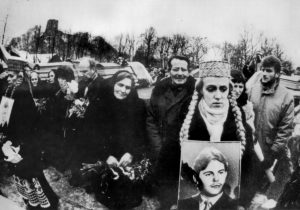
Thirty years after the fact, what significance should we ascribe to January 13, 1991? I presume that for Lithuanians and members of their diaspora who lived through that event, directly or vicariously, it is a wellspring of powerful emotions: sadness, anger, and pride. I know it is for me. Leafing through a pictorial book rushed into print in 1991 by the Lithuanian American Community, Inc., to document the killings in all their horror, I am still touched as I look at a photo of the mourners lined up outside the Sports Arena on the Neris river and read the caption, “500,000 people came to pay their respects to the victims of the massacre at the radio and television tower.” Half a million people – the apotheosis of a nation in mourning. And there’s that word: massacre. I’ve resisted using it to this point, understanding how easily such a powerful term may be dismissed as hyperbole, undercutting the believability of what is being described. “Killing”and “tragedy” are less charged descriptors; “massacre” denotes the indiscriminate and brutal slaughter of human beings. Of course, Lithuanians, as victims, are entitled to use this word — under the circumstances, being scrupulously dispassionate is not required. But interestingly, we’re not the only ones to have identified the killings at the TV tower as a massacre. “At the moment of the massacre, it was still Saturday evening in the United States,” write historian Michael Beschloss and journalist Strobe Talbott in their 1993 book on the end of the Cold War.30 In a book on the same subject published in 2015, British historian Robert Service writes about the role Gorbachev “may have played in the Vilnius massacre.”31 It matters, for the sake of history, how the assault on the TV tower is remembered, both emotionally and objectively. “Massacre” stands the test of time and has embedded itself in the historical record.
The second insight is that, notwithstanding the famous saying “the arc of history bends toward justice,” there are no guarantees about how quickly that arc will bend. Just ask the Belarusians. If the human shields in Vilnius had dispersed before the shooting started, the Alpha unit would have stormed the Russian White House and perhaps in the aftermath a Lenin or Stalin clone would have replaced Gorbachev to save the USSR through a new but familiar wave of terror. Perhaps by Christmas 1991 Landsbergis and Yeltsin would have been dead or in the Gulag.
The third and final insight is that, though it wasn’t evident at the time, January 13 represented the climax of Lithuania’s fight to regain its independence. The March 11 declaration 10 months earlier was a watershed in Lithuania’s post-World War II history. But it wasn’t the decisive event in restoring independence. It is one thing to vote for freedom at the ballot box. It is quite another to stand defiant, unarmed, in the face of a swinging tank turret and an automatic rifle aimed at your head. “Live free or die,”says the famous slogan of the state of New Hampshire. That is the choice the citizens of Lithuania grappled with that January night. When they encountered their moment of truth, they willed themselves to remain free, at any cost. They didn’t just win a reprieve for their democracy; their actions altered the course of history eight months later. As a result, the rotten edifice in which hundreds of millions of people had been forced to live and endure countless deprivations and deformities came crashing down. We should never forget that.
1. Philip Zelikow and Condoleeza Rice, To Build a Better World: Choices to End the Cold War and Create a Global Commonwealth (New York: Hatchette Book Group: 2019) p. 257.
2. Alfred Erich Senn, Gorbachev’s Failure in Lithuania (New York: St. Martin’s Press, 1995) p. 99.
3, Robert Service, The End of the Cold War: 1985-1991 (New York: Public Affairs, 2015), p. 460.
4, Michael Dobbs, Down with Big Brother: The Fall of the Soviet Empire (New York: Alfred A. Knopf, 1997) p. 347.
5. Robert M. Gates, From the Shadows: The Ultimate Insider’s Story of Five Presidents and How They Won the Cold War (New York: Simon & Schuster, 1996) p. 518.
6. Michael R. Beschloss and Strobe Talbott, At the Highest Levels: The Inside Story of the End of the Cold War (Boston: Little, Brown and Company, 1993) p. 294.
7. Gražina Miniotaitė, “Retracing Lithuania’s Steps Toward Independence,” Draugas News, February 15, 2015, p. 16
8. Senn, p. 127.
9. Bronislovas Kuzmickas, Išsivadavimas: Užsienio Politikos Epizodai, 1998-1991 (Vilnius: Apostrofa, 2006) p. 106
10. Miniotaitė, p. 16.
11. Dobbs, pp. 338-339.
12. Jack F. Matlock, Jr., Autopsy on an Empire: The American Ambassador’s Account of the Collapse of the Soviet Union (New York: Random House, 1995), p. 454.
13. https://en.wikipedia.org/wiki/January_Events_(Lithuania).
14. Arunas Liulevicius and Thomas Remeikis (editors), The Gift of Vilnius: A Photographic Document in Defense of Freedom (Chicago: Public Affairs Council, Lithuanian American Community, Inc.) p. 79.
15. Dobbs, p. 348.
16. Senn, p. 137.
17. Gates, p. 499
18. Beschloss and Talbott, p. 308.
19.Anatoly Chernyaev, My Six Years with Gorbachev (University Park, PA: The Pennsylvania State University Press, 2000) p. 318.
20. David Remnick, Lenin’s Tomb: The Last Days of the Soviet Empire (New York: Vintage Books, 1994) p. 395.
21. Beschloss and Talbott, pp. 308-309.
22. Ibid., p. 309.
23. Chernyaev, p. 319.
24. Service, p. 483.
25. Matlock, p. 457.
26. Senn, p. 138.
27. Dobbs, p. 341.
28. Ibid., p. 347.
29. Senn, pp. 138-139; Dobbs, p. 401.
30. Beschloss and Talbott, p. 305.
31. Service, p. 483.
 DRAUGAS NEWS Lithuanian World Wide News in English
DRAUGAS NEWS Lithuanian World Wide News in English
